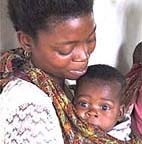|

March 2002
Return to March 2002 contents page
UPDATE
Reports from the sharp end
|
1: Cambodia: safe, non-polluting incinerators
SINCE Cambodia’s Ministry
of Health adopted an injection safety policy in 2000, the
immunization programme has moved fast. It has to: from 2003
the introduction of AD syringes into the routine immunization
system will mean 3 million extra syringes each year for the
system to dispose of, says Keith Feldon, technical officer
for Cambodia’s Expanded Programme on Immunization. This
number does not include AD syringes already being introduced
for supplemental immunizations, nor hospital injections.
The country has chosen to use
small-scale "auto-combustion" incinerators, which usually
use dry combustion materials such as leaves, paper or coconut
husks, and are easy to operate and maintain. With land scarce,
the incinerators are also preferable to burial sites, and
safer for workers to manage. So far, 14 of 24 provinces have
installed them and trained operators, and instructions on
use of the incinerators have been circulated. "This incinerator
seems to be appropriate in terms of cost, training, land space
and potential risk to health workers and the population,"
says Feldon.
|
|
|
| |
A Sicim incinerator,
the type widely used in Cambodia for syringe disposal |
Encouragingly, early findings from
WHO tests of the incinerators show that when they are used properly,
they do not emit harmful amounts of pollutants such as dioxins or
furans. And, although the country has had to invest significant
capital in buying the incinerators, studies suggest that they are
cost-effective with sustained use. Feldon hopes that costs will
fall as local manufacturers of components such as safety boxes and
AD syringes gradually replace expensive imports. He also believes
that equipment manufacturers should take some responsibility for
the costs of disposing of their products.
"It must be remembered that there is no perfect disposal
solution, and that whatever technology is selected is only an intermediate
path until there are improvements in both vaccine delivery methods
and disposal systems."
Phyllida Brown
Return to March 2002 contents
page
|

